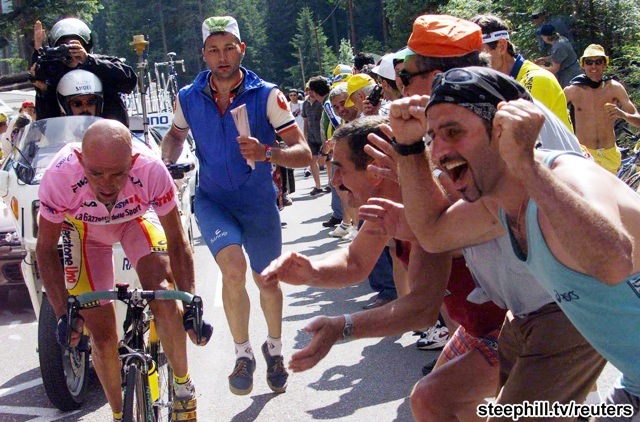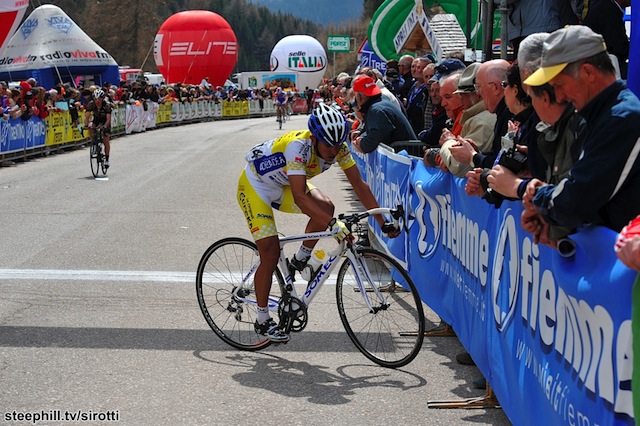
|
Stage |
This stage preview is available in the following languages:
 |  |  |  |  |  |  |
(We are looking for translations in ALL other languages. Please submit your translation with the stage no. and language in the subject title. If you don't see your preview posted within 12 hours then please resend your preview as an attachment if you didn't already do so because we've had problems with some inline character sets like German.)

At the 1999 Giro d'Italia, Marco Pantani launched an extraterrestrial attack, in the drops, over the final 5 km up Alpe di Pampeago that was reported as a "slaughtering" of his rivals
May 24 update: Although this stage hasn't received the same build up as Saturday's Stage 20 summit finish on Passo dello Stelvio, it should prove to be the most important stage of the race in deciding the general classification.
Starting from Treviso, a frequent Giro host, we'll head north for a return visit to the Dolomites. The amount of climbing for Stage 19 is comparable to the previous Dolomites stage, Stage 17, but the climbs on this stage are even steeper.
Besides having five categorized climbs of cat 2 or higher, the most of any stage in this year's race, one of the climbs, Passo Manghen (profile) at km 123, is comparable in length and grade to Passo dello Stelvio. Passo Manghen is slightly shorter, but a little steeper.
After Passo Manghen, the race heads to Alpe di Pampeago, a ski resort climb that will be used for the five time since 1998 as a finishing climb. But unlike previous editions, Alpe di Pampeago will be climbed twice as part of a finishing circuit.
Alpe di Pampeago (10.5 km @ 9.7 %) is slightly harder than Passo Giau which blew apart the race on stage 17 - it's marginally longer and steeper. But the climbs are otherwise different as the road to Alpe di Pampeago is wide and almost devoid of switchbacks. In 1999, Marco Pantani demonstrated how much time you can put into your rivals on a road like this (![]() ) . In just the final 4.5 km, Pantani powered his way (in the drops) and put over one minute into a group of some of the best climbers of that era including Gilberto Simoni, Ivan Gotti and Roberto Heras. Current on-road RAI commentator, Paolo Savoldelli, may recall for us how he lost more than 2 ½ minutes in just those final 4.5 km to Pantani which average 12%. Quite astounding and too good to believe as we would later find out.
) . In just the final 4.5 km, Pantani powered his way (in the drops) and put over one minute into a group of some of the best climbers of that era including Gilberto Simoni, Ivan Gotti and Roberto Heras. Current on-road RAI commentator, Paolo Savoldelli, may recall for us how he lost more than 2 ½ minutes in just those final 4.5 km to Pantani which average 12%. Quite astounding and too good to believe as we would later find out.
In 2003, Gilberto Simoni flew up Alpe di Pampeago and won by 35 seconds. and most recently, in 2008, Emanuele Sella won after a long solo break before testing positive for EPO doping.
So, you can see, Alpe di Pampeago has a storied and checkered past. This year, race leader Joaquim Rodriguez and Ivan Basso will need to drop Ryder Hesjedal on this climb and fortunately for them, they'll have two opportunities since, as mentioned, stage 19 will climb Alpe di Pampeago twice. In total, there are three categorized climbs in the final 40 km of racing. (You can view the details and explore all five of the Stage 19 categorized climbs using the table below)
As Liquigas team boss Roberto Amadio told Velonews, unless Ryder Hesjedal cracks on either Stage 19 or 20, the Giro could be over. Amadio said the flat TT course in Milan points clearly in Hesjedal’s favor against the [pure] climbers: “If he keeps in this position, he can win the Giro,” Amadio told VeloNews. “He can take three minutes out of ‘Purito’ in the time trial and one-and-a-half minutes out of Ivan. We have to hope he has a bad day.”
Among contemporaries, Domenico Pozzovivo (Colnago), 7th overall + 3:19, is one guy who has shown the form lately to be able to win this stage convincingly. He'll need impressive finishes on this stage and stage 20 if he hopes to make the final podium. Pozzovivo will know this finish well since he won at Alpe di Pampeago on the final stage of the 2010 Giro del Trentino — Steve
By the way, this year's Stage 6 winner, Miguel Rubiano, will also know the finish at Alpe di Pampeago well. Here he is barely making it across the line at the 2009 Giro del Trentino:
